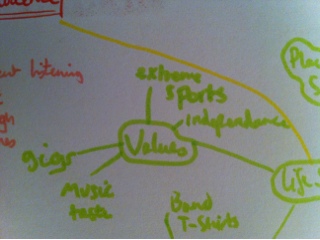Music festivals are becoming more and more specific as more specific and niche genres arise. Music festivals have become more corporate. Festivals like V festival now advertise specific drinks for festivals and have large companies selling their products. Ticket prices have risen and are now approaching £200. Such festivals are hence becoming more mainstream. The increase in price of festivals is considered to be due to increase in illegal file downloads and file sharing. Because of this reduction in profit, ticket prices have increased to compensate and the 'live experience' is promoted - for example the band Muse have a 360 degree video of some of their live performance to gain intrigue into live performance.
Festivals have also evolved to accomodate more specific genres and they have done this by having more stages over large areas and having many different styles playing at once giving the festival-goers more choice.
People also go to festivals because of the recognition that they get for going and the connotations that the festival may stand for, for example Latitude festival has green, hippy style, environmentally friendly connotations.
Saturday, 31 December 2011
Tuesday, 20 December 2011
Tuesday, 6 December 2011
CD cover analysis
This Cover most vividly relates to Queen because of their faces being the only things present on the cover, this is what it reminded me of anyway.
This portrays an image of respect and admiration for musicians alike. The black background connotes a heavier rock/metal background making for a cover of a cultured style suggesting that the band have drawn great influence from these bands/areas. The red title connotes anger, passion and heart which reflect the band well. The faces of the band are clearly represented and therefore their image and identity is shown well as opposed to some CD covers which do not feature the band at all.
This portrays an image of respect and admiration for musicians alike. The black background connotes a heavier rock/metal background making for a cover of a cultured style suggesting that the band have drawn great influence from these bands/areas. The red title connotes anger, passion and heart which reflect the band well. The faces of the band are clearly represented and therefore their image and identity is shown well as opposed to some CD covers which do not feature the band at all.
Monday, 5 December 2011
What does 'White Girl' say about identity, youth, modernist concepts of identity and post-modernist concepts of identity?
White Girl challenges the modernist concept of identity by using a change of location to remove a child (Leah) from the identity that she knows which forces Leah to try on new identities, new cultures/beliefs. The identity given to them by where they lived, and her family. The concept of 'trying on' identities from Michel Maffesoli brings about a method whereby post-modernism is possible. Where we do not have to accept the identity that we 'inherit' or are 'given.
Leah is the oldest daughter of the family. She has a younger brother and sister who stay with their parents throughout the story, adopting their parents fragmented identities. Leah however resists her parents in their battle with morals by finding an alternative identity to escape to. This she uses instead of her parents fragmented relationship to build morals and to be a better person. This lends strongly to the ideas or Paul Ricoeur and Anthony Giddens who believe that we create a narrative of ourselves and that we are constantly creating and evloving our identities. Leah's head scarf is a clear metaphor for her own choice of identity over her parents 'inherited' identity.
Leah's mother eventually comes to accept the post modernist concept and accepts her own freedom as well as her daughters beliefs.
Leah is the oldest daughter of the family. She has a younger brother and sister who stay with their parents throughout the story, adopting their parents fragmented identities. Leah however resists her parents in their battle with morals by finding an alternative identity to escape to. This she uses instead of her parents fragmented relationship to build morals and to be a better person. This lends strongly to the ideas or Paul Ricoeur and Anthony Giddens who believe that we create a narrative of ourselves and that we are constantly creating and evloving our identities. Leah's head scarf is a clear metaphor for her own choice of identity over her parents 'inherited' identity.
Leah's mother eventually comes to accept the post modernist concept and accepts her own freedom as well as her daughters beliefs.
Shot list
- Long shot - power station
- ECUs - Solay
- CUs - Nick
- Panning shot
- Worms eye - Solay
- CU shot taped to guitar
- Long shot - track in
- Track out from ECU
- Silouhettes?
- CU - Equipment
- CU - Effects pedals
- Track across band
- Birds Eye
Subscribe to:
Comments (Atom)




























